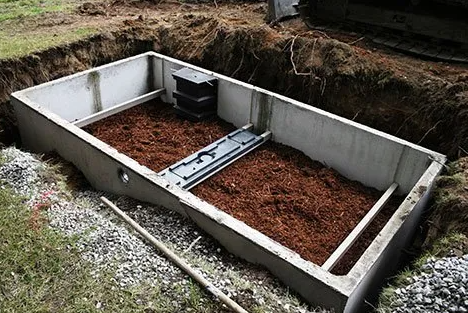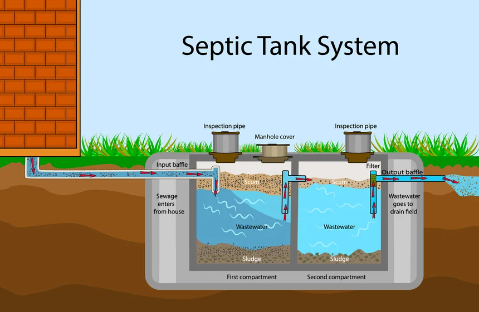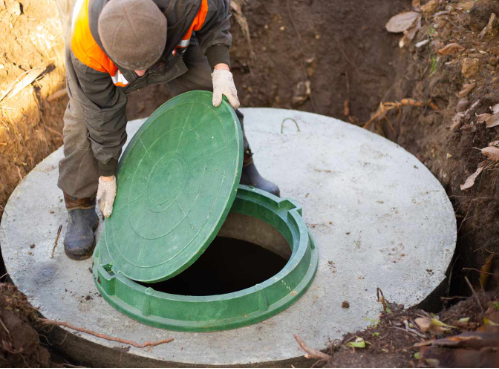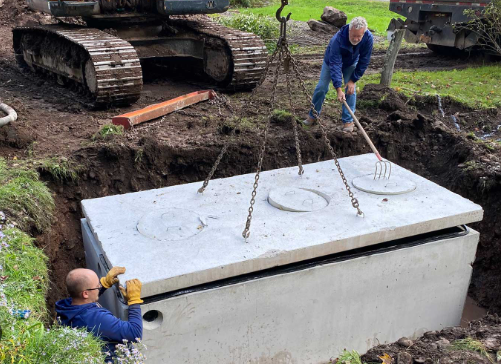How much distance should be between a septic tank and well? Learn about recommended separation distances and guidelines to safeguard groundwater quality in this informative guide.
You’ve just purchased your dream property in the countryside, complete with a charming house, sprawling yard, and even a private well for your water supply.
While the idea of self-sufficiency and the tranquility of rural living are undoubtedly appealing, there’s an essential aspect of property ownership you should be aware of the proper separation distance between your septic tank and well.
Neglecting this crucial detail can lead to contamination of your drinking water and potential health hazards. So, how much distance should be between a septic tank and well to ensure the safety of your well water?
The recommended minimum distance between a septic tank and a well typically ranges from 50 to 100 feet, but this can vary depending on local regulations, soil type, well depth, and septic system design.
It’s crucial to consult your local health department or relevant authorities for specific guidelines in your area, as they may have more stringent requirements to protect your drinking water from potential contamination.
Factors such as soil type and permeability, well depth, and septic system technology all play a role in determining the appropriate separation distance.
Additionally, adhering to best practices such as regular maintenance, proper site assessment, and water quality monitoring can further ensure the safety of your well water.
Also Read: How To Change An Adult Diaper
What’s the difference Between Septic Tanks and Wells?
Before we dive into the specifics of distance requirements, let’s start with a basic understanding of septic tanks and wells.
Septic Tanks
Function and Purpose: Septic tanks are an integral part of a private wastewater treatment system. They are responsible for treating and disposing of the sewage and wastewater generated in your home. Essentially, they act as a miniature sewage treatment plant right on your property.
Components of a Septic System: A typical septic system consists of three main components:
- Septic Tank: This is where the primary treatment occurs. It separates solids from liquids and begins the decomposition process.
- Distribution Box: After initial treatment in the septic tank, liquid effluent flows into a distribution box, which directs it to the drain field.
- Drain Field: This is the final stage where effluent is distributed into the soil for further treatment and disposal.
Also Read: How to Unclog a Toilet Without a Plunger
Wells
Types of Wells: Wells come in various types, but the two most common are drilled wells and dug wells. Drilled wells are constructed by drilling a hole deep into the ground, while dug wells are excavated by hand or with equipment.
Importance of Clean and Safe Drinking Water: Wells are a source of freshwater supply for countless households, particularly in rural areas.
Access to clean and safe drinking water is non-negotiable for maintaining health and well-being. Contaminated well water can lead to a host of health issues and even be life-threatening in severe cases.

Septic Tanks and Wells Regulations and Guidelines
Now that you have a basic understanding of septic tanks and wells, it’s crucial to be aware of the regulations and guidelines that dictate their installation and maintenance. These regulations are in place to protect public health and the environment.
Federal Regulations
While there are federal guidelines related to septic systems and well construction, it’s essential to remember that many of the specific rules are enforced at the state and local levels.
Federal agencies like the Environmental Protection Agency (EPA) provide general guidance but may not cover all the nuances of your particular situation.
State and Local Regulations
State-Level Regulations: Each state typically has its own set of regulations governing septic systems and wells. These regulations can vary significantly from one state to another. They may dictate everything from the minimum separation distance between a septic tank and well to the type of materials that can be used in construction.
Local Health Department Guidelines: Local health departments often have their own set of guidelines and requirements that must be followed. They may also be responsible for issuing permits and conducting inspections.
Also Read: Unlocking Comfort: A Deep Dive into Toilet Distance from Wall
Environmental Protection Regulations
Environmental protection regulations, in addition to health regulations, play a vital role in protecting the environment from contamination caused by poorly designed or maintained septic systems. These regulations can vary widely depending on your location and the ecological sensitivity of your area.
Factors Affecting the Distance Between Septic Tank and Well
The appropriate distance between a septic tank and a well is not a one-size-fits-all measurement. Several factors come into play when determining the right separation distance for your specific situation.
Soil Type and Permeability
How Soil Type Impacts Septic Systems: Different soil types have varying levels of permeability. For example, sandy soils allow water to pass through quickly, while clay soils are less permeable.
Understanding your soil type is essential because it directly affects the ability of the soil to filter and treat the effluent from your septic system.
Soil’s Effect on Well Water Contamination Risk: The type of soil on your property can also influence the risk of contamination.
Sandy soils, while good for septic systems, may allow contaminants to travel more quickly to your well. In contrast, clay soils can slow the movement of contaminants but may be less effective at treating effluent.
Also Read: Distance from Wall to Toilet Flange
Well Depth and Construction
Different Types of Well Construction: The depth and construction of your well matter. A dug well, which is shallower and less secure, may require a more substantial separation distance compared to a drilled well, which is typically deeper and better protected from surface contaminants.
Impact of Well Depth on Contamination Risk: A deeper well may draw water from deeper, more protected aquifers, reducing the risk of contamination from surface sources. However, it’s important to note that deeper wells also tend to be more expensive to construct and maintain.
Septic System Design and Technology
Traditional vs. Advanced Septic Systems: The type of septic system you have plays a significant role in determining separation distances. Advanced septic systems, such as aerobic treatment units or mound systems, often require greater separation distances due to their more complex treatment processes.
Impact of Septic System Design on Contamination Risk: Some septic systems are better at treating effluent before it reaches the drain field. Understanding how your system works can help you gauge its potential impact on well water safety.

Property Size and Layout
How Property Size Influences Distance Requirements: The size and layout of your property matter. Larger properties may have more flexibility in terms of placement, while smaller lots may have limited options.
Irregularly shaped lots may also present challenges in finding an ideal location for both the septic system and well.
Now that you have a grasp of the various factors influencing the distance between your septic tank and well, let’s delve into the recommended minimum distances and best practices.
Recommended Minimum Distance Between Well and Septic Tank
While specific regulations can vary, there are general guidelines and best practices to follow when determining the separation distance between your septic tank and well.
General Guidelines for Separation
In many cases, the recommended minimum separation distance between a septic tank and well is:
- 50 feet: This is a commonly used guideline, but it can vary depending on local regulations and factors like soil type and well depth.
Best Practices for Ensuring Safe Separation
To ensure the safety of your well water and minimize contamination risks, consider the following best practices:
- Consult Local Regulations: Always start by consulting your local health department or relevant authorities to understand specific distance requirements in your area.
- Hire Professionals: It’s advisable to hire professionals for the design and installation of both your septic system and well. They can ensure compliance with local regulations and proper placement.
- Soil and Hydrogeological Testing: Conduct soil tests to assess soil permeability and hydrogeological studies to understand groundwater flow patterns on your property.
- Use Advanced Treatment Systems: If you have a choice, consider advanced septic treatment systems that are designed to reduce contamination risks.
- Regular Maintenance: Maintain your septic system according to the manufacturer’s recommendations and have it inspected regularly to identify and address potential issues.
- Monitor Well Water Quality: Regularly test your well water for contaminants, and keep records of the results.
Case Studies Illustrating Appropriate Distances
To gain a better understanding of how these guidelines and best practices work in real-life scenarios, let’s explore a couple of case studies:
- Case Study 1: A rural property with well-drained sandy soil installs a traditional septic system and a drilled well. Due to the soil’s good permeability and the deeper well, they maintain a separation distance of 100 feet as recommended by local regulations.
- Case Study 2: A suburban property with clayey soil installs an advanced aerobic treatment unit septic system and a dug well. To account for the less permeable soil and the shallower well, they follow local guidelines and maintain a separation distance of 200 feet.
These case studies illustrate how various factors, including soil type, well depth, and septic system type, can influence the recommended separation distance.

Maintenance and Inspection
Ensuring the safety of your well water doesn’t stop at the initial installation and separation distance. Regular maintenance and inspection are crucial aspects of long-term well water quality.
Importance of Regular Septic System Maintenance
Proper septic system maintenance is essential for preventing issues that could lead to contamination. Here are some key maintenance tasks:
- Pumping: Schedule regular pumping of your septic tank to remove solids and prevent buildup.
- Inspecting for Leaks: Check for leaks or signs of system failure, such as wet spots in your yard or foul odors.
- Monitoring Effluent Levels: Keep an eye on effluent levels in your distribution box to ensure proper flow to the drain field.
- Avoiding Excessive Water Usage: Be mindful of water usage to prevent overloading your system.
Monitoring Well Water Quality
Regular testing of your well water is your first line of defense against contamination. Common contaminants to test for include bacteria (e.g., E. coli), nitrates, and other harmful chemicals. Many health departments recommend testing at least once a year, and more frequent testing may be necessary in areas with known contamination risks.
Signs of Potential Contamination
Be vigilant for any signs that your well water may be contaminated. These can include:
- Changes in water taste, color, or odor
- Illness or health issues among family members
- Dead vegetation or unusual growth patterns near the well or septic system
- Unusual noises or behaviors in your plumbing
If you notice any of these signs, it’s essential to address the issue promptly and seek professional assistance if necessary.
Bonus Tips for Property Owners
As a property owner, there are several steps you can take to ensure the safety of your well water and maintain the recommended separation distance:
Steps to Take When Installing a Septic System or Well
- Consult Local Authorities: Begin by contacting your local health department or relevant regulatory agency to understand the requirements and regulations in your area.
- Hire Professionals: Engage qualified professionals for the design, installation, and inspection of your septic system and well.
- Site Assessment: Conduct a thorough site assessment, including soil testing and hydrogeological studies, to determine the best placement for your septic system and well.
- Follow Local Guidelines: Adhere to local regulations and guidelines for separation distances and construction standards.

What to Do If Your Property Doesn’t Meet Recommended Separation
In some cases, due to property size or other constraints, it may be challenging to meet the recommended separation distance. Here’s what you can do:
- Consult Authorities: Contact your local health department to discuss possible solutions or variances.
- Explore Alternative Systems: Consider alternative septic system technologies that may require less separation.
- Water Treatment: Invest in additional water treatment, such as filtration or disinfection systems, to ensure the safety of your well water.
- Additional Precautions to Safeguard Your Well Water
- Regular Testing: Establish a routine for testing your well water, and keep records of the results.
- Education: Educate yourself and your family on proper well and septic system care to prevent accidental contamination.
- Proper Waste Disposal: Dispose of household waste, chemicals, and pharmaceuticals correctly to prevent them from entering your septic system.
- Landscaping: Be mindful of landscaping around your septic system and well to avoid damage or interference.
Conclusion
Your property’s septic system and well are crucial components of your everyday life, providing you with clean water and wastewater disposal. Ensuring the right separation distance between them is essential for safeguarding your health and the environment.
By following local regulations, considering various factors like soil type and well depth, and maintaining both systems properly, you can enjoy the benefits of rural living without compromising on the safety and quality of your well water.
Remember, it’s your responsibility as a property owner to prioritize the health and safety of your drinking water. By doing so, you’re not only protecting your family’s well-being but also contributing to the conservation of the environment and the well-being of your community.







